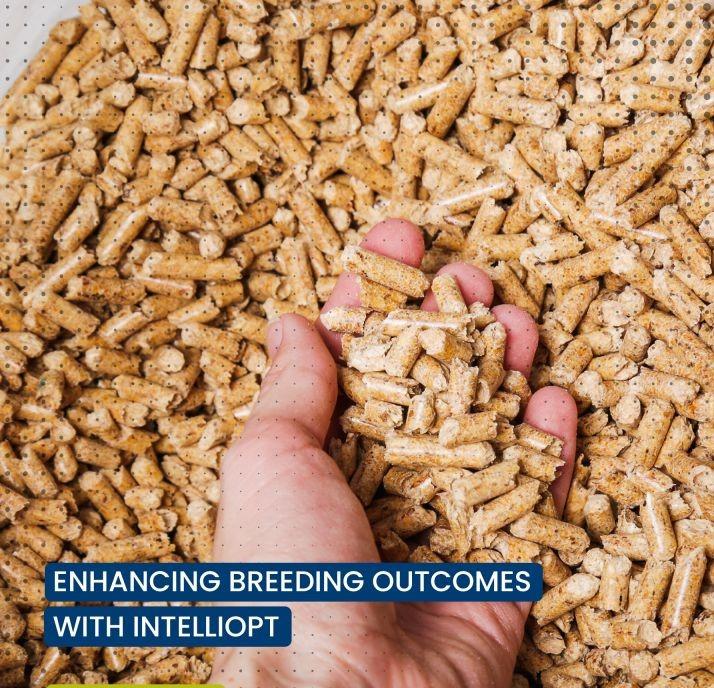Explore all the information on
Minerals in poultry nutrition
Minerals in poultry nutrition are typically classified as macro- or micro-minerals, depending on the levels needed in the diet. The macro-minerals include calcium, phosphorus, chlorine, magnesium, potassium, and sodium. Requirements for the macro-minerals are typically expressed as a percentage of the diet, while the requirements for the micro-minerals are stated as parts per million. Although the quantities required for micro-minerals are lower than for macro-minerals, they play an essential role in the body's metabolism. The micro-minerals include copper, iodine, iron, manganese, selenium, and zinc.
Mike Persia (Virginia Tech) explains the characteristics of aragonite, how it is harvested, and its potential as a calcium source for poultry nutrition, in this Engormix interview during IPPE 2024 in Atlanta, USA....
Comments : 0
Recommendations: 0
Duarte Neves (Zinpro) explains how amino-acid complexed mineral supplementation to broiler breeders can positively impact eggshell quality and translucency, in this Engormix interview during IPPE 2024 in Atlanta, USA....
Comments : 0
Recommendations: 0
Álvaro Gordillo (BASF) explains his research presented at IPPE 2024 in Atlanta, USA, and comments on the bioavailability and microencapsulation of vitamins, during this Engormix interview....
Comments : 0
Recommendations: 1
John Boney (Pennsylvania State University) comments on improvements in egg production with superdosing of phytase while reducing phosphorus, in this Engormix interview during IPPE 2024 in Atlanta, USA....
Comments : 0
Recommendations: 1
Fausto Solís (The Wenger Group) speaks on a replacement of calcium carbonate in layer diets, as well as the importance of magnesium levels, during this interview at IPPE in Atlanta, USA....
Comments : 0
Recommendations: 0
Soybean meal (SBM) and canola meal (CM) are two plant-based protein sources which contain reasonable amounts (2.9 and 6.8 g/kg, respectively) of calcium (Ca). Currently, no published values are available for the Ca digestibility in SBM and limited studies (Anwar et al., 2018; Moss et al., 2018) are available for the Ca digestibility in CM. Microbial phytases are now routinely added in poultry diets to improve the bioavailability of phosphorus (P) bound to phytate (myo-inositol hexaphosphate)...
Comments : 2
Recommendations: 3
Joshua Jendza (Qualitech) talks about avoiding pathogen growth while providing iron to the bird, and how iron works against Salmonella and other bacteria, during this Engormix interview....
Comments : 0
Recommendations: 2
Mycotoxins interfere in the vitamin D metabolism leading to poor calcium absorption, causing Lameness. Does anyone agree to this point? ...
Comments : 8
Recommendations: 2
I. INTRODUCTION With ongoing genetic selection for improved persistency of lay and feed efficiency (FE) in laying hens, the egg industry is pursuing the opportunity to extend layer hen lifespan until they are 100 weeks of age (WOA), with an aim for each hen to produce up to 500 eggs. This presents some challenges for the hen as during this longer laying cycle she will be producing more than 31 kg of egg product (Muir et al., 2022c) and using approximately 1 kg of calcium (Ca) to...
Comments : 0
Recommendations: 0
I. INTRODUCTION Calcium (Ca) and phosphorous (P) are two essential minerals for the skeletal growth and other biological functions in poultry. Maintaining an appropriate balance between Ca and P is necessary as these minerals are closely associated in their absorption and post absorptive utilisation. Because of the recent works on the measurement of digestible Ca in feed ingredients, initiative has been taken to determine the standardised ileal digestible (SID) Ca and SID P...
Comments : 0
Recommendations: 1
I. INTRODUCTION Calcium (Ca) is an important nutrient for skeletal development, muscle contraction, nerve impulses, acid-base balance, and a cofactor for blood clotting and endogenous enzymes. Due to the involvement of Ca in numerous functions in the body, accurate supply of dietary Ca is essential for optimal growth, feed efficiency and nutrient utilisation. Oversupply of dietary Ca or an imbalance between dietary Ca and phosphorus (P) has been linked to significant reductions in...
Comments : 0
Recommendations: 3
I. INTRODUCTION Phytase is commonly used in broiler diets at a typical dose level of 1000 FTU/kg feed to increase the P availability from phytate and reduce the need for inorganic phosphate inclusion. Increasing the phytase dose above this level is expected to further reduce the need to add inorganic phosphate and further reduce P excretion. In addition, if a phytase can break down phytate quickly and completely in the upper gastrointestinal tract, it will mitigate the...
Comments : 0
Recommendations: 0


Lost in the Market Uncertainty Caused by the Outbreak
Suggested link
Coccidiosis is a disease caused by Eimeria spp. and causes a negative economic impact on the poultry industry, inducing global losses over 2.4 billion dollars annually (1). Specific Eimeria spp. identified in poultry includes E. acervulina, E. brunetti, E. maxima, E. necatrix, E. praecox, E. mitis, E. tenella, E. mivatti, and E. hagani (2). Eimeria spp. colonize in the intestine from duodenum to ceca, leading to inflammation, hemorrhaging, and diarrhea. Damaged intestine caused by...
Comments : 0
Recommendations: 1
1 INTRODUCTION Modern broilers grow three to four times as quickly as earlier generations (Browning & Cowieson, 2013). Leg disorders, bone weakness, and broken bones are common problems in broilers that are attributed to poor growth, downgrading at slaughter, and reducing the bird’s routine activities, such as walking, standing, eating, and drinking subsequently causing economic loss at the end (Bell & Weaver, 2002; Manohar et al., 2015; Meseret, 2016;...
Comments : 0
Recommendations: 0
I.INTRODUCTION A high degree of volatility with regard to the pricing and supply of inputs has arisen. This situation began with the COVID-19 pandemic and the negative effect it had on the global supply chain, and has been exacerbated by the Russian-Ukrainian war. This state of affairs will likely persist until at least the end of 2023 (Mulder, 2022). It has given rise to the intermittent non-availability of several essential feed ingredients. Coupled with these short- to medium-term...
Comments : 0
Recommendations: 0
Minerals such as copper, manganese and zinc are essential nutrients for enzyme functionality, immune system responses, tissue and bone quality as well as eggshell formation (Richards et al., 2010). Organic trace minerals are used in animal feeds to provide increased mineral bioavailability. In this experiment we investigated the benefits of hydroxy analogues of chelated trace minerals on pullet quality. Three hundred- and sixty day-old Isa Brown layers were randomly allocated into two groups...
Comments : 0
Recommendations: 0
I. INTRODUCTION The following statement was made by Landers et al., (2012) in a public health report. “Although the majority of antibiotic use occurs in agricultural settings, relatively little attention has been paid to how antibiotic use in farm animals contributes to the overall problem of antibiotic resistance”. Some classes of antibiotics are becoming less effective due to overuse and microbial adaptation leading to resistance to treatment. The pool of...
Comments : 0
Recommendations: 0
Introduction Brazilian agriculture is concentrated in the tropical and subtropical zone, where soils are highly weathered and chemically infertile, demanding amelioration by liming and high amounts of plant nutrient inputs (Cantarella et al., 1998). In Brazil, soybean is the main crop both in scale and in value, covering ~38 M ha with an average yield of 3.5 t ha−1 (Cattelan and Dall'Agnol, 2017; EMBRAPA, 2022). Annually, about 1.2 M t of P are required to produce...
Comments : 0
Recommendations: 0
Breeding is crucial in livestock management, ensuring continuous production and maintaining genetic excellence. Better breeding results mean healthier offspring, higher birth rates, and enhanced herd or flock health. Nutrition is pivotal for breeding success in most livestock. Balanced diets, rich in essential vitamins, minerals, and nutrients, help animals achieve their full reproductive potential. We present IntelliOpt, the solution for effective nutrient utilization...
Comments : 0
Recommendations: 0
An organic mineral is a combination of a metal ion with an organic molecule called ‘ligand’ such as amino acids, proteins, polysaccharides, yeast, or organic acids. Specifically, the metal ion is bound to the organic ligand through multiple attachments (either ionic or covalent) with the metal ion occupying a central position in the structure (Kincaid, 1989, Nelson, 1988). Animal Trace Mineral Requirements aren’t Static: Poultry feeds must be formulated...
Comments : 9
Recommendations: 4



.jpg&w=3840&q=75)




.jpg&w=3840&q=75)
































